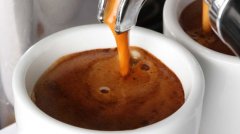How to diagnose the problem of espresso extraction (part two)

(the information is from the Internet. I have slightly modified it for sharing reference only. if the editor of this article does not agree to share, please contact me to delete it.)
What is important and what is not important
People really seem to be attracted (or captivated) by the most unusual details of the espresso extraction process. These details cover the brewing temperature from the espresso machine (this is important, but do you really think the problem with the cup of coffee you just extracted is because your coffee machine doesn't have an electronic temperature control system?) To incredibly complex filling techniques, to bizarre cleaning rituals and other aspects.
The fact is that the extraction of a cup of espresso alone involves more than 100 variables. As a result, it was like a dance. Or, perhaps more precisely, it is the part that twirls in the process of dancing with a partner. Um... Well, it's complicated. How does it have anything to do with dancing? He should be trying to say that all these variables have to work closely together to get a great cup performance in the end.)
Anyway... We try to consistently control as many variables as possible. But there will always be changes, and there will always be changes. So... I think the key is to focus on the most critical variables and then understand the relationship between all of these variables and how they affect the results. By understanding this, you can focus on the results. (key variables and the relationship between all variables and their output)
The key to Outstanding espresso (Keys to exceptional espresso)
So what are the key variables? Well, some variables can be reduced to constants, such as brewing temperature, brewing pressure, and the consistency of coffee and bean grinders. So let's assume that the equipment you have is acceptable and that you have good quality fresh coffee. Under this premise, what key variables should a barista focus on?
1. Grind.
Grinding is a variable that should be kept as a variable. In general, the goal is to try to achieve consistency and adjust a little while leaving other variables unchanged. Now... Of course... It is very "Zen". Amitabha Buddha ~ I guess he wants to say: "Don't say, don't say, it's wrong to say"). I mean, it's basically impossible (and therefore it's impossible to understand the relationships between all variables). In any event, grinding is the variable you use. I mean, you adjust your espresso extraction by adjusting the grinding. Learn how changes in grinding affect other things, and trying to understand the complexity of grinding is 90% of the job of being a barista.
two。 Powder (Distribution).
Powder is the most misunderstood and ignored, but it is the really key variable that you can control. In order to get a good cup of espresso, the necessary condition and goal is to make a uniform density coffee cake in the filter bowl. This is actually a very important thing. Most baristas (professional or enthusiastic fanatics) this is where technology fails the most. When distributing coffee in a filter bowl becomes a method, there are a lot of ideas. Two of them seem to be the easiest to master, the most predictable, and the most reliable are Schomer's method and Stockfleths Move (video). It's best to find out which one is right for you, practice, and then master it. Always keep in mind that the goal is... Get a uniform bed (a coffee cake of uniform density in a filter bowl). If you do the right thing, then your chance of getting the right extraction will go all the way and go higher.
3. Packing pressure (Dosing).
For each type of coffee, there is a range that consists of your filling pressure and a complete set of grinding, powdering, filling and extraction styles. It's simple. All you have to do is stay in that window. The goal of the tolerance is that 0.1g may be too much, but it's best to achieve it, but 0.5g is really a big variable. It's worthwhile to take some time to practice packing. A good practice is to try to divide and powder in a clean and fully dry filter bowl, and then pour the coffee powder into a clean, dry paper cup. Repeat it nine times and weigh it each time. Keep training until your tolerance reaches your personal goal (0.3g I suggest).
To be honest, when it is assumed to be a constant, everything is not that important. For example, pressing powder is not as important as everyone thinks. Your goal of pressing the powder is to protect the powder just now and to build a sufficiently solid surface. You need consistent powder pressing, but again, you need to be consistent in everything you do. It is not that only consistent pressing powder is the most important.) .
It is important to remember that it is important to keep the powder that has just been done. It should not be destroyed as soon as the powder is nearly evenly distributed. How can you destroy the powder that has already been made? The most common methods are: hit the brewing handle (we have all seen baristas use the powder press and the brewing handle as percussion music); not enough pressure; click the cooking handle on the fork of the bean grinder; press it with a small powder press many times; and so on.
Anyway... Back to pressing powder. Basically, if you protect the results of the powder separation, use at least 30 pounds of pressure, use a fixed pressure powder, do not grind the powder under pressure so as not to damage the powder, and so on. That's all I need.
So... Are there any other "confused" variables? By the way, time and extraction become tools to help you adjust the grinding to get close to the correct grinding. When you are close-when you are adjusting the bean grinder towards the correct grinding, you begin to taste. At that point, anyway, throw away these tools! This is not only an art, but also a technology, which means that the standard of evaluation is just taste. So instead of looking at the stopwatch, look at the outflow of espresso. Although you try your best to be consistent, there will still be changes (not only your skills, but also other factors). So when you watch the coffee flow out, you adjust the flow and time according to the coffee flow. Taste, taste, taste. Because at the end of the day... The last thing that really matters is the performance in the cup (not the size, not the time, not what it looks like, pull.)
Important Notice :
前街咖啡 FrontStreet Coffee has moved to new addredd:
FrontStreet Coffee Address: 315,Donghua East Road,GuangZhou
Tel:020 38364473
- Prev

Is the coffee with tiger spot a good cup of coffee?
The so-called tiger spot generally means that the oil of ESPRESSO has the same markings like tiger fur, which is definitely not the oil that a good ESPRESSO should have. The tiger spot is generally caused by the high water temperature of the coffee machine, the long time the handle stays on the brewing head, the fine grinding, the uneven filling pressure and so on. The solution is to check the pressure of the boiler first.
- Next

Understanding the extraction rate is the basis of making a cup of espresso
What I want to tell you in the article is that the concept of extraction rate is not difficult, and there is little relationship between extraction rate and concentration, and extraction rate is very important, which you need to know as a barista. The article will mention several questions: (1) the concept of gold cup criterion; (2) the relationship between extraction rate and concentration; (3) knowing the extraction rate, it is meaningful for us to adjust the grinding degree and powder quantity every day, and then we can make it better.
Related
- Beginners will see the "Coffee pull flower" guide!
- What is the difference between ice blog purified milk and ordinary milk coffee?
- Why is the Philippines the largest producer of crops in Liberia?
- For coffee extraction, should the fine powder be retained?
- How does extracted espresso fill pressed powder? How much strength does it take to press the powder?
- How to make jasmine cold extract coffee? Is the jasmine + latte good?
- Will this little toy really make the coffee taste better? How does Lily Drip affect coffee extraction?
- Will the action of slapping the filter cup also affect coffee extraction?
- What's the difference between powder-to-water ratio and powder-to-liquid ratio?
- What is the Ethiopian local species? What does it have to do with Heirloom native species?

